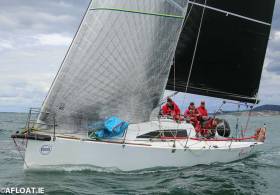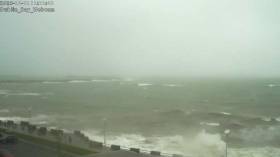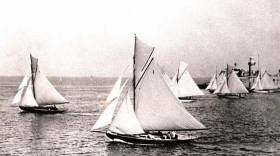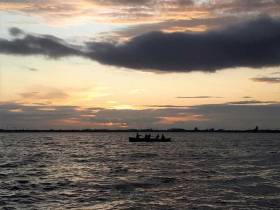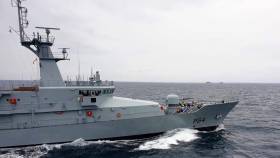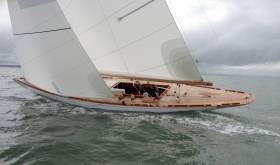Displaying items by tag: Dublin Bay
The New Dun Laoghaire? Could Restored Classic Marguerite Point the Way Towards a Reimagined Harbour?
Anyone sailing in Dun Laoghaire on one of those gentler days which have occasionally punctuated this Autumn’s meteorological extremities could have been forgiven if they thought they were seeing a ghost writes W M Nixon. White of hull – very white – and with antique-style hand-made sails of pale cream, her clipper bow and long counter stern place this elegant little vessel in the High Victorian era as she slips effortlessly along, leaving scarcely any trace of wake in the best ghost-like traditions.
But she was real. Real enough to evoke the time when Dublin Bay Sailing Club was still the newly-formed disruptor which had first appeared in 1884. Real enough to recall that the innovating 1870-formed Royal Alfred Yacht Club was continuing to develop fresh ideas in the forefront of the international codification of the yacht racing rules.
For this little wonder is Guy and Jackie Kilroy’s newly-restored 25ft cutter Marguerite, which first sailed in 1896, but was built by a traditionalist who reckoned the classic yachts of the late 1880s and early 1890s were the peak of naval architectural achievement both for beauty of line, and for performance and seaworthiness. In Marguerite, he built his dream.
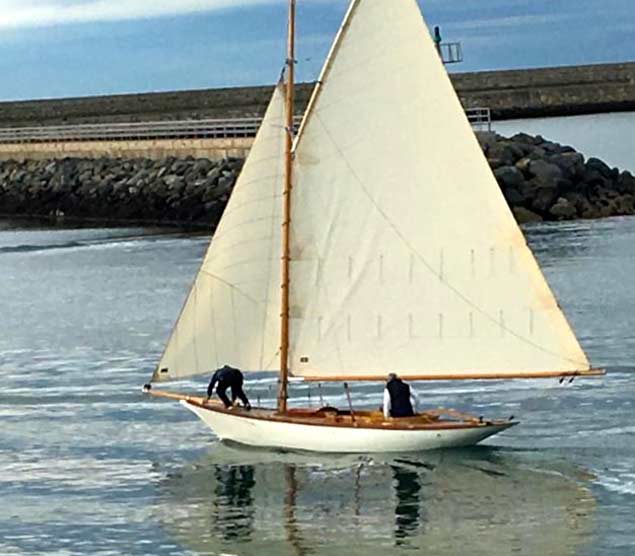 Marguerite has her first sail in restored form, September 2019. Photo: David Williams
Marguerite has her first sail in restored form, September 2019. Photo: David Williams
This boatbuilder was quite something. His busy little yard was in Malahide, but though he was called Jack Wellington, that was an adopted surname, for he was actually Norwegian or Swedish, though nobody quite knew which. It was an easy enough confusion to make, for until 1905 they were a united kingdom with Sweden the dominant partner. But in the small estuary community which was then Malahide, it didn’t much matter either way, as they were accustomed to seafaring men who appeared from God’s knows where, and found a peaceful place to settle in the little village, particularly if they were shipwrights before they were sailors, for the little boatyard was always busy.
Eventually, Jack took it over, and was doing well with fishing boat work such that in 1896 it was decided to build a little yacht. Whether it was for a customer or for Jack himself we don’t know, but we do know that for at least a quarter of a century thereafter, Jack Wellington was the main man on board when Marguerite went sailing and racing.
For her lines, he’d persuaded Herbert Boyd across in Howth – who had designed and built the remarkably accomplished 27ft Eithne in 1893 – to lend him Eithne’s very basic drawings, and he simply scaled them down a bit, and Marguerite was a 25ft version of Eithne.
 Herbert Boyd’s Eithne as she was in 1895, flying the Commodore’s burgee of the newly-established Howth SC
Herbert Boyd’s Eithne as she was in 1895, flying the Commodore’s burgee of the newly-established Howth SC
Herbert Boyd went on to design the Howth 17s in 1897, and they first raced in 1898. But though he would take the helm of one of them from time to time for a race, Eithne remained his first and truest love. She was possibly the smallest-ever yacht listed as owned by the Commodore of the Royal Alfred YC when he was elected to that role for a distinguished period in office, having by now inherited his father Judge Boyd’s baronetcy to become Sir Walter Boyd Bt. In fact, he kept Eithne from when he had built her in the boatshed beside Howth House in 1893 until his death in 1948, and until the late 1920s her closest rival in racing was often her little sister Marguerite from Malahide.
In time, Marguerite passed to members of the Jameson whiskey family, but continued to be based in Malahide, and in the late 1940s she was being sailed by a young Mungo Park - a direct descendant of the legendary explorer, he was Mungo Park VII - but Marguerite came to him through the fact that his mother was a Jameson. He soon moved on to larger boats, becoming one of the keenest owner-skippers in the Dublin Bay 24 Class, and in 1973 his Chance 37 Tam O’Shanter was the top-placed Irish boat in that year’s Fastnet Race, thereby making Mungo Park the first winner of the Gull Salver.
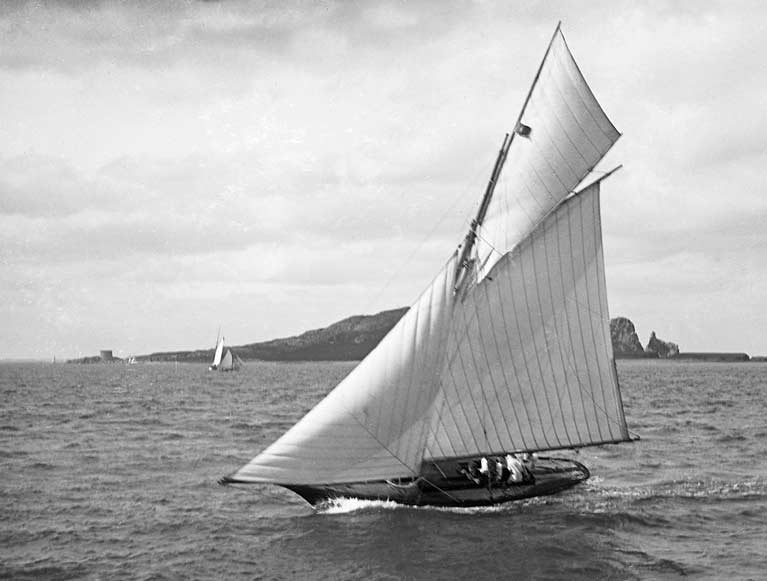 Marguerite in 1896, the only surviving photo of her earliest days.
Marguerite in 1896, the only surviving photo of her earliest days.
As for Marguerite, she was inevitably showing her age and was sold away from Malahide. But somehow she survived, and in the late 1990s, the newly-retired Tim Magennis of Dun Laoghaire – probably the only Irish sailor to have gone round the world under gaff rig, having done it in the 1960s in the Colin Archer ketch Sandefjord – was looking for a retirement project. He was inspired by the fact that Sean Cullen, the son of his skipper on Sandefjord, had restored Eithne in 1984, and when he got to hear that Marguerite was in Arklow in a somewhat sorry state but still eminently restorable, his life path was mapped out for the next twenty years.
He managed to get Marguerite moved to a shed in the old ESB pole-field on Dublin’s East Wall Road, where a select group of Poolbeg Y & BC members winterized their yachts, and there he was able to draw on East Wall’s long-established boat-building skills to bring Marguerite back to life. Her original elegant counter had long since been shortened, but Tim wanted it restored. So I was delegated to bring Mungo Park in from Howth for a conference on how that stern had originally looked, which resulted in what must have been the one and only yacht design consultation which had ever taken place in the Wharf Tavern with a member of the Royal Yacht Squadron leading the discussion.
Despite such high-flying advisers, as he lived on his retirement pension Tim was determined to keep the Marguerite restoration within very manageable expenditure and running costs, so paint was readily used instead of expensively applied varnish, and the “new” suit of sails was assembled from anything remotely suitable on the second-hand market – it is believed that the enormous light weather staysail originally graced an International Dragon, while the mainsail was on permanent loan from a Howth 17.
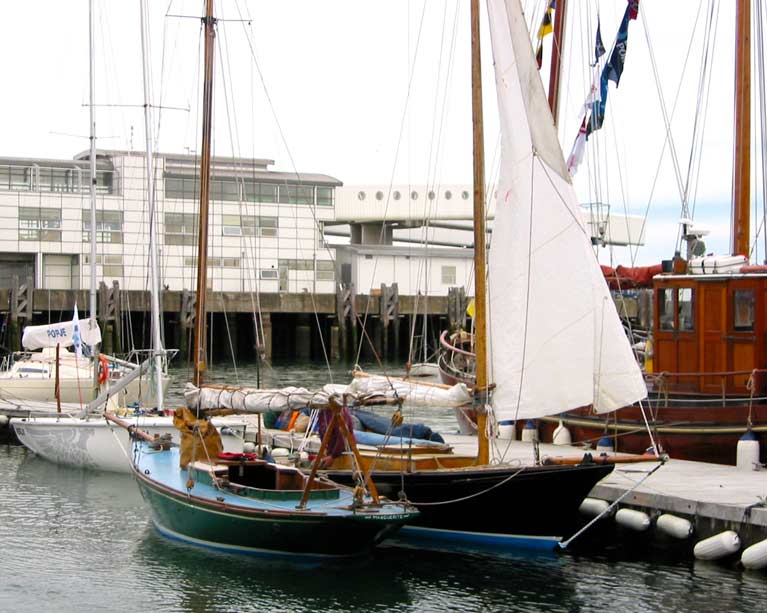 Marguerite and Eithne together at a Woodenboat Rally in Dun Laoghaire in 2003, shortly after the former’s 1999 restoration. Photo: W M Nixon
Marguerite and Eithne together at a Woodenboat Rally in Dun Laoghaire in 2003, shortly after the former’s 1999 restoration. Photo: W M Nixon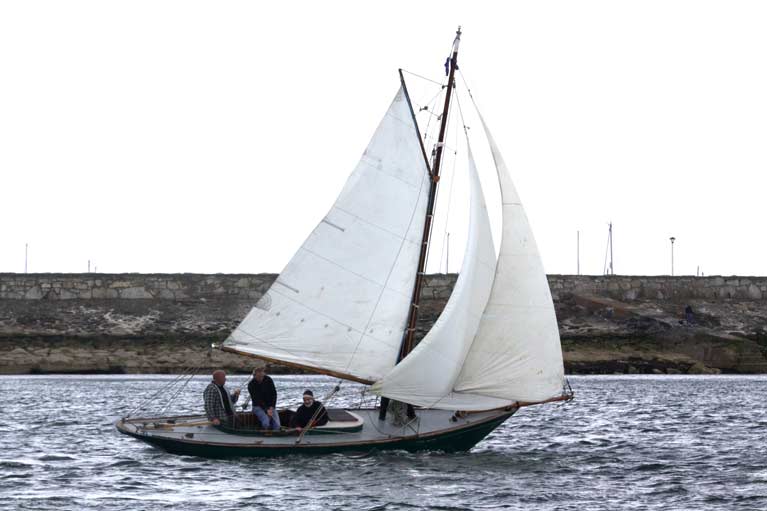 Marguerite as she was in 2013, run as economically as possible and using a mixture of sails. Photo: W M Nixon
Marguerite as she was in 2013, run as economically as possible and using a mixture of sails. Photo: W M Nixon
However, a neat little new engine was installed in order to avail of a tight-fit mooring in the Coal Harbour – not something granted to everyone, but there were many who wanted to help Tim Magennis – and for fifteen years and more, Marguerite in her basically-restored but neatly maintained style was a welcome feature among the newer craft and the utilitarian boats of the Irish National Sailing School in the inner harbour.
Tim Magennis being an enthusiastic member of the Old Gaffers Association, for the season of 2012-2013 he was President of the Dublin Bay OGA when the cream of the OGA fleet came to Dublin Bay as part of their Golden Jubilee, and the little Marguerite gallantly played her role as the flagship of as diverse an assembly of boats as the Liffey has ever seen, with Sean Walsh of the DBOGA becoming the OGA’s President, an international role.
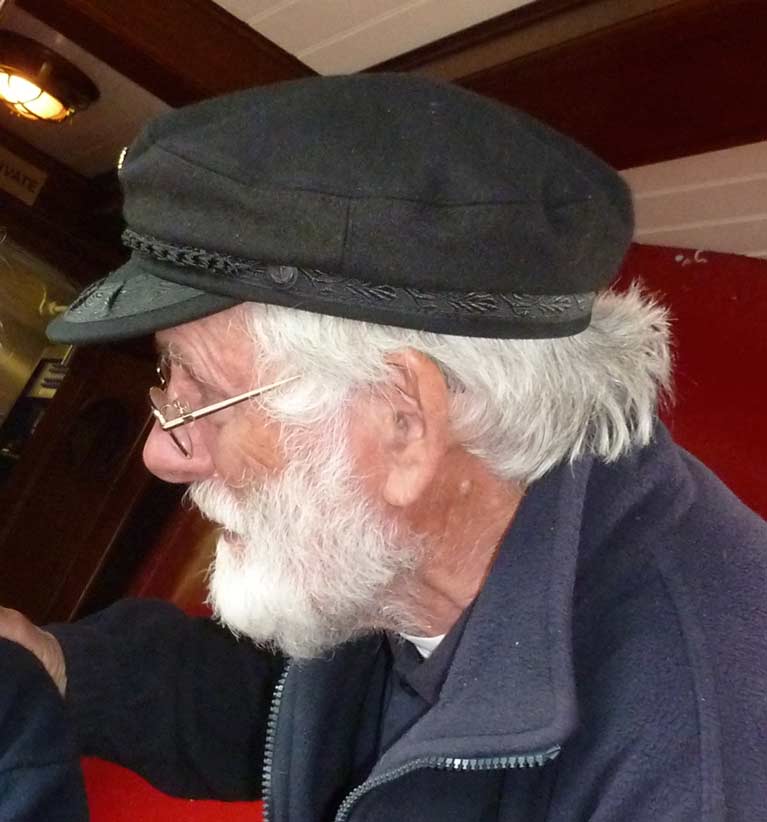 Tim Magennis in his role as President of the Dublin Bay Old Gaffers Association. Photo: W M Nixon
Tim Magennis in his role as President of the Dublin Bay Old Gaffers Association. Photo: W M Nixon
In time, Tim Magennis became an Honorary Member of the OGA, but with his 90th birthday approaching, he was acutely aware that continuing to maintain the Marguerite was becoming too demanding, yet he realised that finding the right people to take her on and maybe give her a full-on classic boat restoration was going to be no easy task.
Looking back now, perhaps it’s a pity that Tim’s main career was in the publicity department of Bord Failte in its developing days, for although he was brilliant at his job, he would have been of great value to the Department of Foreign Affairs, as his skills as a diplomat, persuader and selector of People Who Get Things Done are world class. Having observed the remarkable selection of boats taking part in the OGA Golden Jubilee, he had reckoned that Ian Malcolm of the Howth 17s was in a league of his own in his networking abilities, and at some gaff-rigged gathering he took him aside and asked did he know of anyone who might take on the mission of bringing Marguerite to her true glory, and keeping her there.
Not only is Ian Malcolm one of the main movers in keeping the vintage Howth 17s intact, but he is a committed owner-sailor with the classic Water Wags in Dun Laoghaire, and among their number he knew that Guy Kilroy – who thought so much of the Water Wags that he’d had a completely new boat to the 1900 Maimie Doyle design built by Jack Jones of North Wales - but now was showing the signs, readily recognised by a fellow enthusiast, of needing a much more demanding new project.
And that project was right there with the Marguerite, which always needed work done just to keep her seaworthy, but needed a major job to lift her into classic boat status. By 2017 the outline of an agreement had been worked out between Tim and Guy. But the prospects for the project were made no easier by the fact that Guy and his wife Jackie preferred to have the job done in the Greater Dublin area so that he could keep a close eye on it, for decisions would be needed on an almost daily basis.
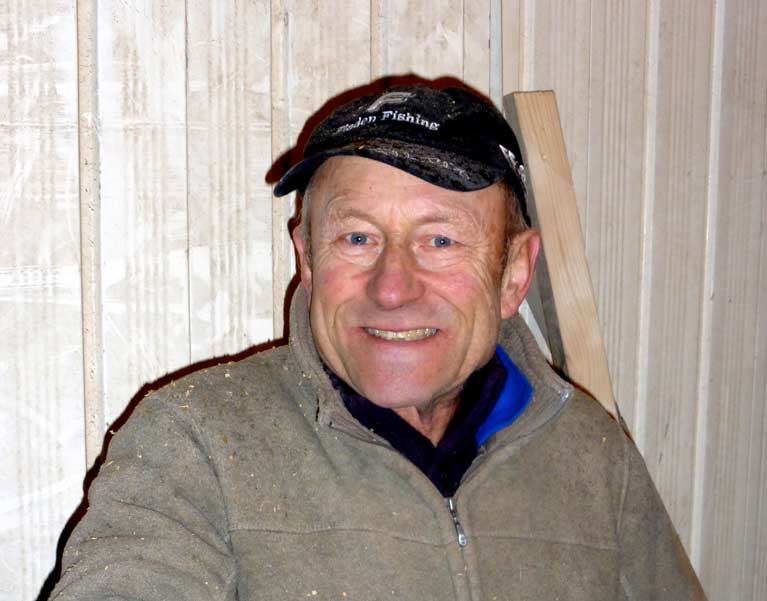 Boatbuilder extraordinaire – Larry Archer is a skilled shipwright in almost every material
Boatbuilder extraordinaire – Larry Archer is a skilled shipwright in almost every material
Fortunately, that star-of-all-trades in boat-building, Larry Archer of Malahide, had secured himself the use of a substantial shed out in the country behind the back of Dublin Airport, a pearl beyond price in a city almost totally devoid of proper marine industry premises. In it, Larry and his right-hand man Paul Fowley were always busy with keeping the Howth 17s in full working order, building a sweet little dinghy to go with the original Asgard in Collins Barracks in order to match the dinghy seen in the famous photo of Erskine & Molly Childers when they were cruising the Baltic in Asgard, and generally getting on with getting things done things.
Bringing Marguerite up to a standard which she had possibly never reached in her long life was right up Larry’s street, and in due course she became the main job in the shed, always gradually progressing even as other more minor jobs came and went.
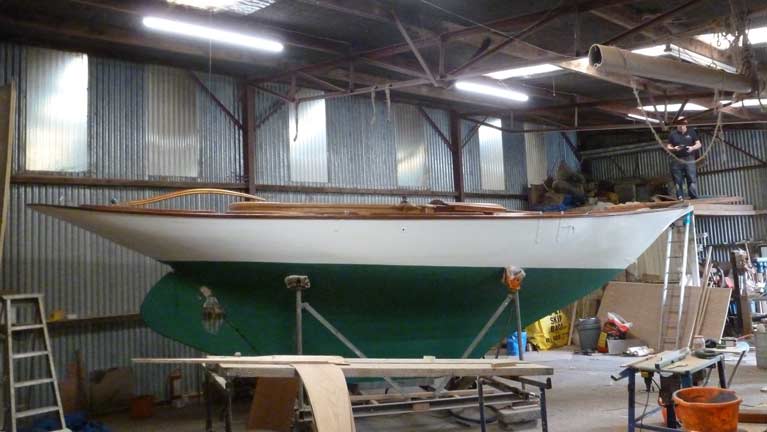 Getting there – Marguerite in the shed “somewhere beyond the airport”, Spring 2019. Photo: W M Nixon
Getting there – Marguerite in the shed “somewhere beyond the airport”, Spring 2019. Photo: W M Nixon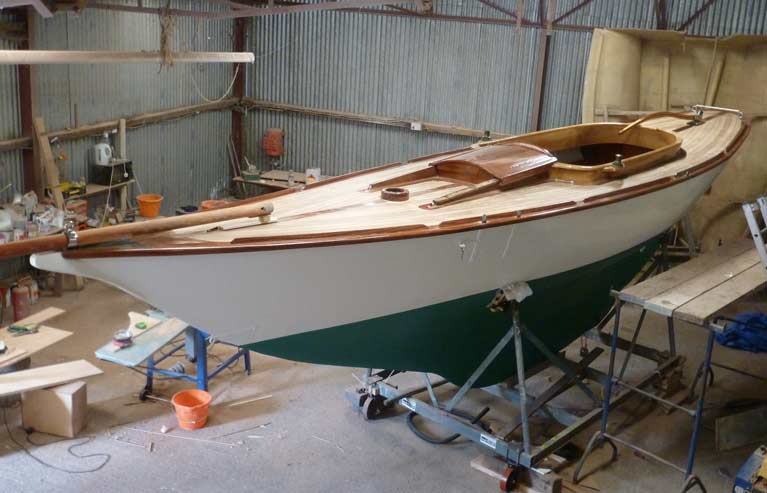 The new deck, hatch and cockpit set the style for the restoration. Photo: W M Nixon
The new deck, hatch and cockpit set the style for the restoration. Photo: W M Nixon
The ambition was to make Marguerite as close as possible to what she had been in 1896. The boat herself was of course available for the basic concept, but despite that high-flown design conference in the Wharf Tavern twenty years ago, there was a feeling that the counter still wasn’t exactly 1896. As for the coachrooof, judging by the only 1890s photo available, the comfortable little cabin as maintained by Tim Magennis was very different from the rather austere virtually flush deck with sliding hatch arrangement indicated in the original.
As well, Marguerite has rather slim sections aft, which greatly helps her speed in light airs, but it meant that the little engine installed in 1999 tended to make her sit a bit by the stern, so Guy Kilroy was very clear that he wanted a new engine installed further forward.
Regarding the cockpit and deck generally, both were to be finished to the highest standards, while in the hull itself, any timber over which there was the slightest question was to be replaced, the ballast keel was to be new bolted, the hint of a clipper bow in the original was to be very definitely retained, and the question of a classic counter – a vague design area with both the restored Eithne and Marguerite - was solved by replicating as far as possible the counter on the Dublin Bay 21s, as good as was ever seen in Dublin Bay.
 At last….inspired by the lines of the Dublin Bay 21, Marguerite finally has a truly classic counter again. Photo: W M Nixon
At last….inspired by the lines of the Dublin Bay 21, Marguerite finally has a truly classic counter again. Photo: W M Nixon
The original gaff sloop rig was to be re-created using old photos, and the sails and spars in classic style were ordered from Paul Robert’s renowned L’Ateliers d’Enfer traditional marine industry and boat-working school complex in Douarnenez in Brittany, where Ian Malcolm was regularly visiting as it was the location for the re-build on the Howth 17 Anita, lost except for her ballast keel in the destruction of the pier-end boat store shed in Howth during Storm Emma in March 2018.
Thus in the end several different places contributed to the re-birth of Marguerite, but the real focus of the action was in the shed in the unlikely setting of that hugely productive agricultural territory west of the airport, and it was summer 2019 before Marguerite could finally be moved to her designated home port of Dun Laoghaire for the final finishing jobs and the sometimes trial-and-error fitting of the new rig.
She’d been finished in pure white topsides with copper-green underside in proper classic yacht style, but it was expected that the boot-top would have to be raised once she was in full day-cruising trim, and as the photos show, such is the case, and she’ll look even better for it.
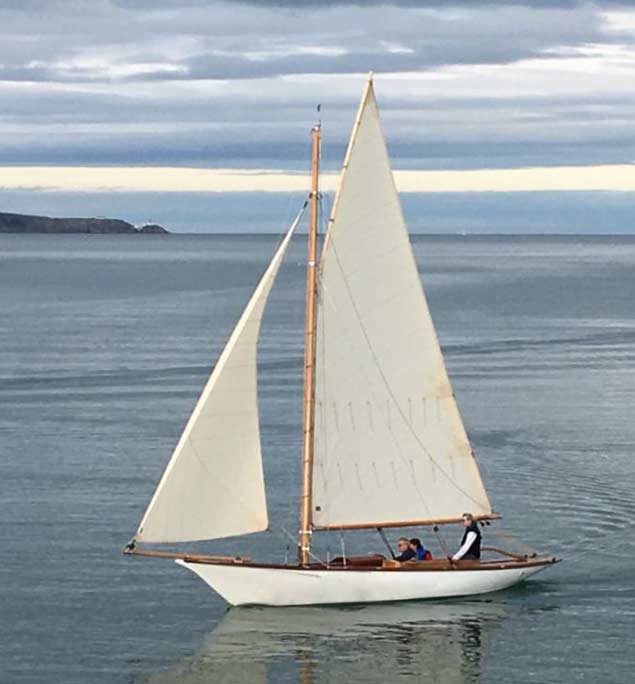 She moves easily through the water with very little fuss, and when the boot-top has been raised as expected, she’ll look even better. Photo: David Williams
She moves easily through the water with very little fuss, and when the boot-top has been raised as expected, she’ll look even better. Photo: David Williams
What with other distraction inevitable in a busy sailing season, it was well into September when Marguerite finally sailed again, and there’s still work to be done. But in due course Dun Laoghaire will have yet another addition to its increasingly varied line-up of true classic yachts, and with two official surveys now under way as to the harbour and harbour area’s future, we can only hope that this increasing interest in classics will be recognized as yet another asset for the harbour as it might be.
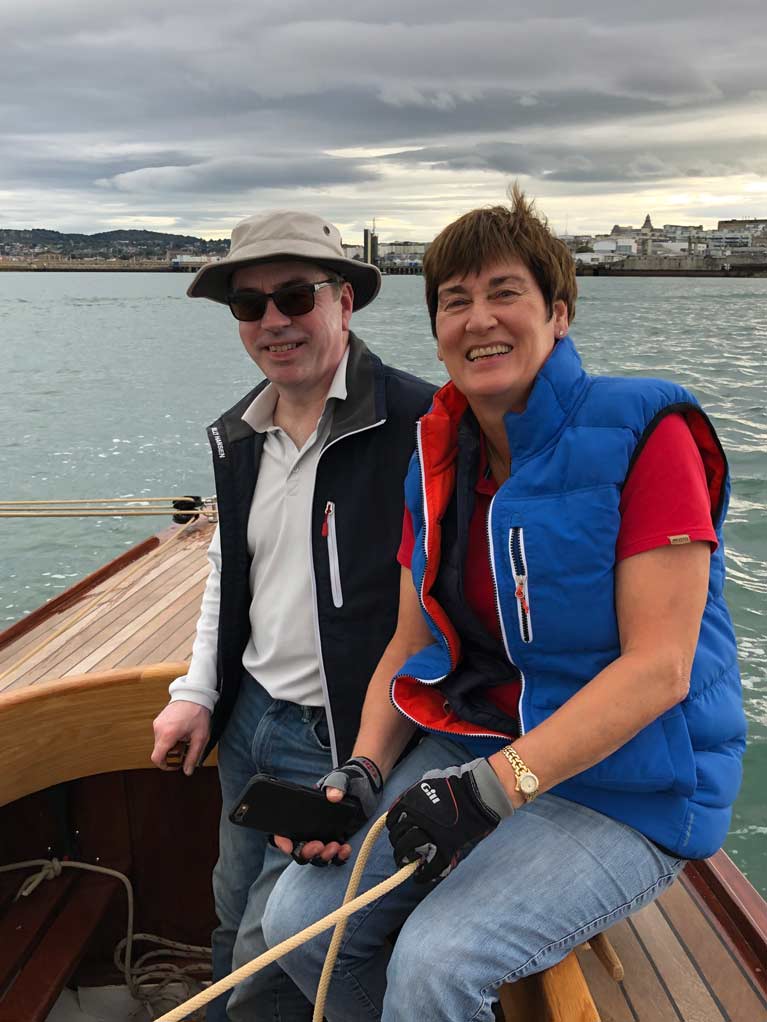 Has it really happened? Guy and Jackie Kilroy on their first sail in their restored 1896-vintage Marguerite. Photo: Ian Malcolm
Has it really happened? Guy and Jackie Kilroy on their first sail in their restored 1896-vintage Marguerite. Photo: Ian Malcolm
For Dun Laoghaire is a classic artificial harbour – indeed, it could probably be best described as a neo-classical harbour. A magnificent structure in itself, it is great augmented by the style and vitality of the three waterfront yacht clubs, each a splendid classical building in its own right.
So although new buildings and new boats will be needed for new and useful additions such as the proposed National Watersports Complex, proper attention should also be paid to the potential for a focal point for classic boats and yachts, and their special requirements.
The historic Water Wags are already a great strength of the harbour scene. The attractive International 12s – once such a feature of the harbour in times past – are making a comeback. The first of the restored Dublin Bay 24s – Periwinkle – is now back in the harbour. The reintroduction of the Dublin Bay 21s is only a matter of time. And the clinker-built Mermaids of 1932 and the IDRA 14s of 1946 also spring to mind for possible revival.
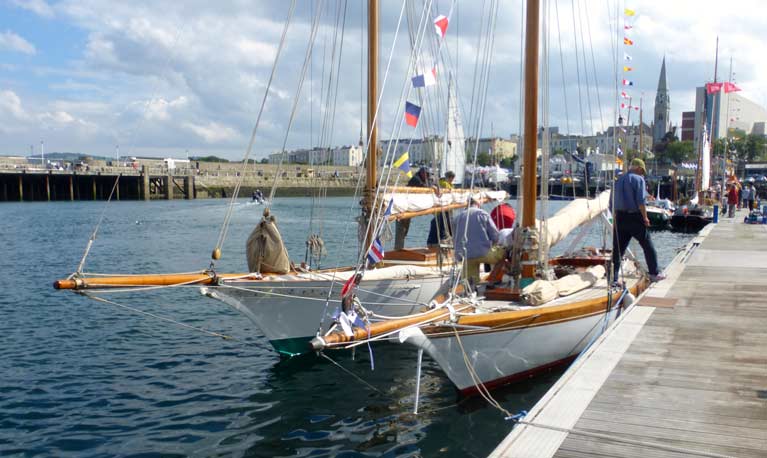 A glimpse of what might be – Peggy Bawn (1894) and Myfanwy (1897) together in Dun Laoghaire in 2017. Photo: W M Nixon
A glimpse of what might be – Peggy Bawn (1894) and Myfanwy (1897) together in Dun Laoghaire in 2017. Photo: W M Nixon
Thus the arrival of Marguerite gives a new dimension to possibilities which were first revealed when Hal Sisk in 2005 brought the superbly-restored 1894-vintage Peggy Bawn back to the harbour which had been her home port since 1919, a dimension which had been emphasised when she got together with the 1897-vintage Myfanwy at the Harbour’s Bicentenary in 2017.
Dun Laoghaire’s past, and the living history of its sailing, become central its future. The story of the restoration of Marguerite, and what she has now become, has been drawn into the Dun Laoghaire Harbour story. And the story of Marguerite and her survival and restoration is a credit to all involved.
DBSC Results for Saturday, 28 September 2019
There was a good turnout of 102 boats for the last race of the DBSC Summer Series this afternoon on Dublin Bay with two races for all classes and 4 races for IDRA 14s.
The results of the last race day are below.
Race 1
Cruiser 0 IRC: 1. Tsunami, 2. Lively Lady, 3. D-Tox
Cruiser 0 Echo: 1. Tsunami, 2. Lively Lady, 3. D-Tox
Cruiser 1 IRC: 1. Raptor, 2. Something Else, 3. Dear Prudence
Cruiser 1 Echo: 1. Jump the Gun, 2. Raptor, 3. Dear Prudence
Cruiser 1 J109: 1. Something Else, 2. Dear Prudence, 3. Jump the Gun
31.7 One Design: 1. Attitude, 2. Fiddly Bits, 3. Kernach
31.7 Echo: 1. Fiddly Bits, 2. Kernach, 3. Attitude
Cruiser 2 IRC: 1. Gwili Two, 2. Leeuwin, 3. Peridot
Cruiser 2 Echo: 1. Gwili Two, 2. Leeuwin, 3. Springer
Cruiser 2 Sigma 33: 1. Gwili Two, 2. Leeuwin, 3. Pastiche
Cruiser 3 IRC: 1. Dubious, 2. Asterix, 3. Ceol Na Mara
Cruiser 3 Echo: 1. Dubious, 2. Asterix, 3. Pamafe
Cruiser 5 NS-IRC: 1. Cevantes, 2. Act Two, 3. The Great Escape
Cruiser 5 Echo: 1. Cevantes, 2. Afternoon Delight, 3. Act Two
SB20: 1. Carpe Diem, 2. Venuesworld.com, 3. Black
Sportsboat Hcap: 1. Jester, 2. Jheetah, 3. Jambiya
Flying 15: 1. Flyer, 2. Fflagella, 3. Perfect Ten
Ruffian: 1. Ruffles, 2. Ruff Diamond, 3. Alias
Shipman: 1. Jo Slim, 2. Viking, 3. Invader
B211 One Design: 1. Ventuno, 2. Small Wonder, 3. Bees Wing
B211 Echo: 1. Ventuno, 2. Small Wonder, 3. Bees Wing
Squib: 1. Periquin, 2. Sidewinder
Glen: 1. Glencoe, 2. Pterodactyl, 3. Glendun
IDRA 14: 1. Slipstream, 2. Dart, 3. Dumoanin
Race 2
Cruiser 0 IRC: 1. Tsunami, 2. Wow, 3. D-Tox
Cruiser 0 Echo: 1. Tsunami, 2. Wow, 3. D-Tox
Cruiser 1 IRC: 1. Jalapeno, 2. Chimaera, 3. White Mischief
Cruiser 1 Echo: 1. Dear Prudence, 2. Jump the Gun, 3. Gringo
Cruiser 1 J109: 1. Jalapeno, 2. Chimaera, 3. White Mischief
31.7 One Design: 1. Bluefin Two, 2. Prospect, 3. Kernach
31.7 Echo: 1. Bluefin Two, 2. Kernach, 3. Kalamar
Cruiser 2 IRC: 1. Peridot, 2. Rupert, 3. Springer
Cruiser 2 Echo: 1=. Springer, 1=. Peridot, 3. Rupert
Cruiser 2 Sigma 33: 1. Rupert, 2. Springer, 3. Leeuwin
Cruiser 3 IRC: 1. Cartoon, 2. Maranda, 3. Ceol Na Mara
Cruiser 3 Echo: 1. Maranda, 2. Ceol Na Mara, 3. Cartoon
Cruiser 5 NS-IRC: 1. Cevantes, 2. Act Two, 3. The Great Escape
Cruiser 5 Echo: 1. Cevantes, 2. Aurora, 3. Calypso
SB20: 1. Venuesworld.com, 2. Carpe Diem, 3. Black
Sportsboat: 1. Jester, 2. Jheetah, 3. Jambiya
Flying 15: 1. Fflagella, 2. Gulfstream, 3. Rhubarb
Ruffian: 1. Ruffles, 2. Carmen, 3. Alias
Shipman: 1. Viking, 2. Invader, 3. Jo Slim
B211 One Design: 1. Small Wonder, 2. Bees Wing, 3. Yikes
B211 Echo: 1. Ventuno, 2. Small Wonder, 3. Bees Wing
Squib: 1. Sidewinder, 2. Periquin
Glen: 1. Glendun, 2. Glenshesk, 3. Glencoe
IDRA 14: 1. Dumoanin, 2. Slipstream, 3. Dart
Race 3
IDRA 14: 1. Slipstream, 2. Dart, 3. Dumoanin
Race 4
IDRA 14: 1. Dumoanin, 2. Dart, 3. Slipstream
Dublin Bay Live Webcam: Big Waves at Dun Laoghaire
As another weather system ahead of Hurricane Lorenzo starts to makes its presence felt on the Irish East coast today, below is the current scene at Dun Laoghaire on Dublin Bay viewed northwards from Sandycove on this Dun Laoghaire Harbour and Sandycove webcam.
Met Eireann has said there is still some uncertainty over the future path of Hurricane Lorenzo, but it expects to have more precise details tomorrow. The forecaster has been working with the US National Hurricane Center and others to try and predict the storm's route. Met Eireann's Jean Byrne said: "The closer we get to the event, obviously, the better idea we should have. Luckily the models are coming in a little bit more into line, so I think we are fairly confident at this stage it will track close to Ireland, at least, if not over it.
High Water at Dun Laoghaire is 2pm
Climate Action Report Claims Dublin Bay Sea Level Rising Faster Than Forecast
Dublin Bay’s sea level seems to be rising faster than forecast — and at twice the global average over the past two decades.
The Irish Times reports on this startling claim from Dun Laoghaire-Rathdown County Council’s (DLRCoCo) climate change action plan, which also notes that weather extremes are “likely to increase in their frequency and intensity”.
The report comes following one of Ireland’s hottest summers on record, itself just months after a first ever Status Red warning for snow was issued by Met Éireann.
Three Dublin local authorities launched their climate action plans on Monday (9 September), with DLRCoCo’s plan pledging to “prioritise nature-based flood defences where possible” over the next five years.
The Irish Times has much more on the story HERE.
Make Sailing Simple Again – Some Committee Boat Starts Can Work Against Racing Enjoyment
Our header photo this week may not be the greatest in terms of clarity and technical brilliance, let alone jaw-dropping drama writes W M Nixon. But it tells us much about our peculiar sport of racing under sail, that two genuine and experienced sailing enthusiasts could examine this photo in detail and argue for hours about whether it is a Good Thing, or a Travesty of Sporting Justice.
It shows the Dublin Bay 25 class making a start through the mouth of Dun Laoghaire Harbour, which would have been Kingstown when the image was taken, as it’s probably pre-1914. But even were it in the 1920s or ’30s, many of the locals – including, one would think, practically everyone on these yachts - continued to call it Kingstown even though it had officially reverted to Dun Laoghaire in 1920, meaning that it had been Kingstown for just 99 years.
Be that as it may, it shows a classic summer’s day - probably a Saturday afternoon, though they had racing on some weekday afternoons too in the GODs (the Good Old Days) – and an easterly sea breeze is making as the 25ft LWL class, the aristocrats of the Dublin Bay One Design scene and the J/109s of their time, get their race under way.
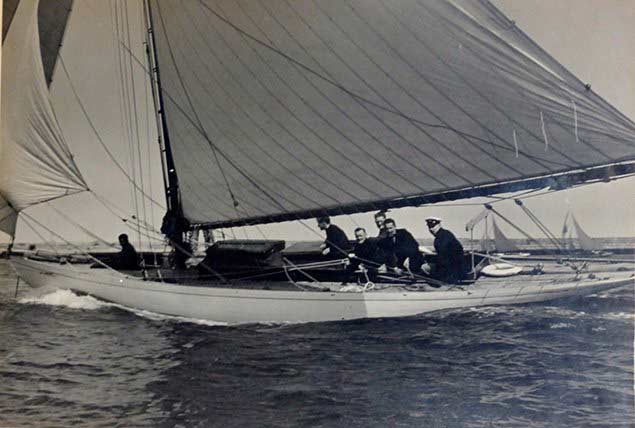 The J/109s of their day – the Purcell brothers’ DB 25 Acushla racing on Dublin Bay in 1938. An early owner was the legendary international tenor John McCormack, and Macushla was one of his most popular songs
The J/109s of their day – the Purcell brothers’ DB 25 Acushla racing on Dublin Bay in 1938. An early owner was the legendary international tenor John McCormack, and Macushla was one of his most popular songs
It may well be that their actual start was made in-harbour from a mark boat off the waterfront for the convenient viewing of the many members and their guests in the distinguished clubhouses (who would have observed proceedings for about four minutes as it was otherwise interrupting their lunch, but never mind). Thus it might be said that in accessing Dublin Bay through the harbour mouth, they were getting two starting lines for the price of one.
But either way, the last thing on anyone’s mind was the thought that people should go to much trouble – or indeed any trouble whatever – to provide a starting line which was at exactly 90 degrees to the basic wind direction. On the contrary, the thinking at virtually all sailing centres was that you should get the boats away as quickly and conveniently as possible from a start line near their moorings, and finish them in similar style. For in those pre-auxiliary-engine days, finishing at some distance from home with the wind failing was a big turn-off in every sense of the term, and it was certainly bad for club racing’s popularity.
Anyway, that header photo, which is such a long up the page by now that we’ll show it again, would seem to suggest that the boat on the left – no 2, Punctilio which was the last DB25 to leave Dun Laoghaire, she was here until the 1970s – is well set up, as they’re probably racing towards a first mark in mid-bay. She’s nicely on a closer-than-close reach but not actually hard on the wind, she’s just hitting the edge of the seaward-going ebb which will sharpen the breeze and enable her to sail at the optimum angle, and she looks to have freed herself from getting any dirt from the group close under the east pier.
 Here’s that start again for further examination
Here’s that start again for further examination
But don’t dismiss them entirely. The boat right under the lighthouse may be carrying her way with limp sails through a small calm spot. But within seconds she will be getting a benefit from the mini tide rip which swirls round the pier end, and suddenly her overall position could be transformed.
For in the GODs, the boat which has had the best start was the boat which was best placed after about a mile of racing. And who knows, but it might even be the boat in the foreground, No 1 which could either be Whisper built in 1898 by local shipwright J E Doyle, or it could be Fodhla built in 1903 also by J E Doyle.
For Fodhla was built for the Viceroy, the Earl of Dudley and the nascent 25ft class were so chuffed that Himself up in The Park was getting one of the boats (it was a surprise present from his wife) that they decided Fodhla should also be No 1. Only in Dublin Bay would they have two No 1s, while they never ever had a No 13.
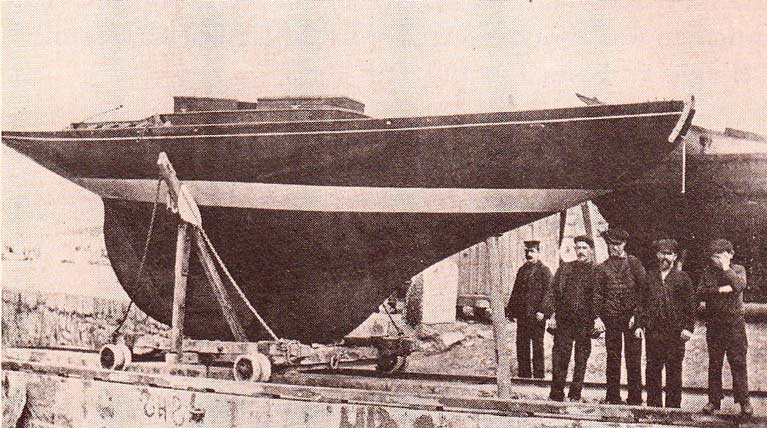 The new Fodhla ready for launching by builder J E Doyle into the Coal Harbour in what was then Kingstown in 1903. As the owner-to-be was the Viceroy, the class association caused eternal confusion by making her No 1 when they already had a No 1, built in 1898. Photo courtesy DBSC.
The new Fodhla ready for launching by builder J E Doyle into the Coal Harbour in what was then Kingstown in 1903. As the owner-to-be was the Viceroy, the class association caused eternal confusion by making her No 1 when they already had a No 1, built in 1898. Photo courtesy DBSC.
Anyway, Fodhla or Whisper or whatever is going like a train as she carries a private puff of breeze from within the harbour, but you’ll notice that her racing flag atop the jackyard tops’l suggests she is reaching, yet they already have her trimmed for the wind being well ahead of the beam, in anticipation of the significantly different direction outside.
Or it could be we’re flattering No 1’s crew? Maybe they’ve been surprised by this sudden puff from abeam or even slightly aft of it. But as it’s only going to last for a few seconds until they get into the basic breeze in the bay, it’s hardly worth their while adjusting the four different sheets which the complex rig of the DB25 requires, and it’s only going to cause confusion with the sister’s son, young Willie, who is trying to make himself comfortable in the sunshine on the lee deck, and fell overboard last time out, costing them a couple of places……
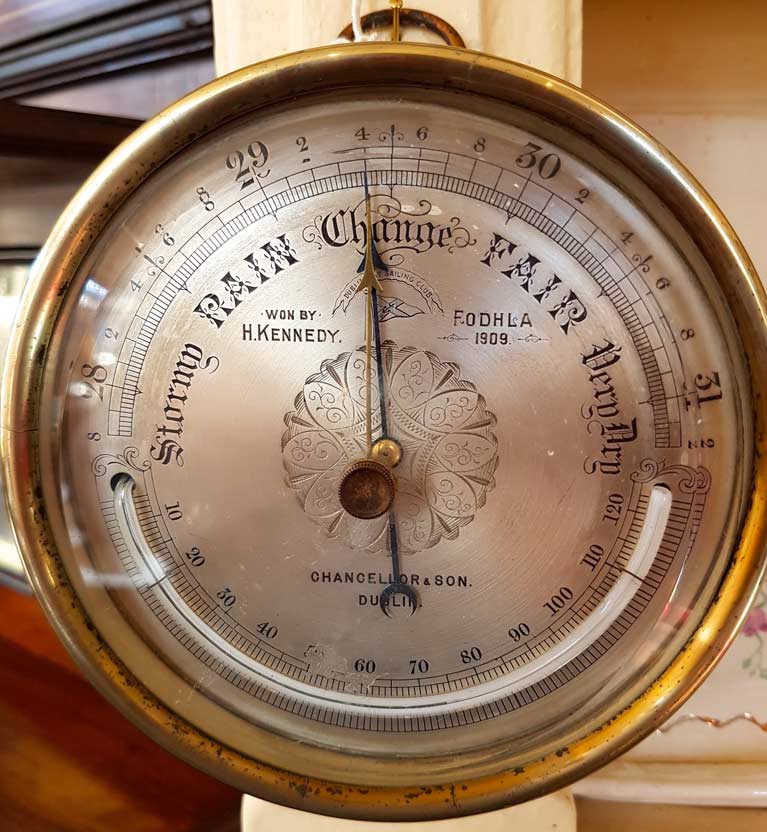 Fodhla was only briefly in the ownership of the Viceroy – by 1909 she was winning races for one H Kennedy, as this DBSC prize barometer from Vandeleur Antiques of Kilrush reveals.
Fodhla was only briefly in the ownership of the Viceroy – by 1909 she was winning races for one H Kennedy, as this DBSC prize barometer from Vandeleur Antiques of Kilrush reveals.
Be that as it may, we’re assuming one of our experienced observers is a sailor who enjoys racing which is as much an interaction with coastal features and local quirks of sea and weather as it is with the straightforward achieving of boat speed in clear relatively tide-free water, and he or she sees this start as a delightful challenge.
But equally we assume the other is a purist whose highest ideal is Olympic sailing in waters as interference-free as possible, with courses of a very set type with a starting line virtually at 90 degrees to the wind, which must be of minimal strength and steady direction, racing round marks well clear of any land influence with minimal and preferably no tide, and putting the emphasis on windward-leeward courses in which the crews are always busy busy busy. He or she, therefore, sees this start as a lazy luck-reliant shambles.
 The beau ideal of a modern start, far at sea and dead to windward, with an extra mark boat at mid-line set back a very few feet to keep the sighted line in order
The beau ideal of a modern start, far at sea and dead to windward, with an extra mark boat at mid-line set back a very few feet to keep the sighted line in order
Inevitably, in an era when public awareness of sailing just about extends to Olympic medals and no further, the Olympic disease is spreading down to every level of our sport. Characterful starting huts on the end of piers or on picturesque shoreside seapoints, both with eminently sensible transit markers setting the line, are discarded in favour of Committee Boats, mark-laying RIBs, and a general support cast of dozens of pious folk including, God help us, umpires…...
"the Olympic disease is spreading down to every level of our sport"
Even back in the 1990s, it was sometimes at the stage where there seemed to be more people on the management side than were actually racing the boats. But the 1990s being the final years of that prelapsarian era before 24/7 electronic communication meant that you now never knew when you actually have time off, even though I was churning out verbiage at a ridiculous rate for many printed publications with the odd book to make things truly manic, deadlines meant that was it - job done and goodbye, you were all clear, and some civilised diversion could be planned without a thought for what should be going onto some ever-active communication screen.
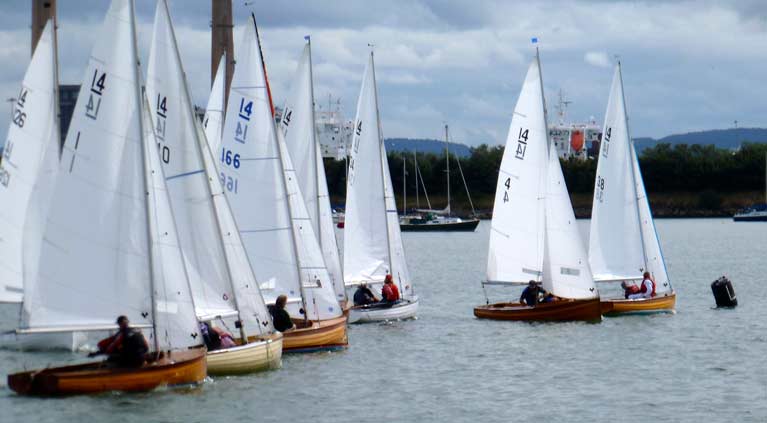 A spectator-friendly start for the IDRA 14s at Clontarf for their 70th Anniversary Race in 2016 in an area which dries out at low water. The line had been set from the shore to give a slight disadvantage to starboard tack boats, but a sudden backing of the light breeze accentuated this. Nevertheless the start proceeded, and while Andy Sargent in Dusk (no 4) has pulled off the port tack start, Gerry Sargent in Starfish is just able to make the pin on starboard, and he went on to win with Dusk second. Photo: W M Nixon
A spectator-friendly start for the IDRA 14s at Clontarf for their 70th Anniversary Race in 2016 in an area which dries out at low water. The line had been set from the shore to give a slight disadvantage to starboard tack boats, but a sudden backing of the light breeze accentuated this. Nevertheless the start proceeded, and while Andy Sargent in Dusk (no 4) has pulled off the port tack start, Gerry Sargent in Starfish is just able to make the pin on starboard, and he went on to win with Dusk second. Photo: W M Nixon
So anyway, after one particularly exasperating Race Week when the Organising Committee had insisted the Race Officer set the start line well away from harbour or any land, meaning we spent half the day getting there and back, I used the grapevine of the club bars to air an idea about a race among like-minded souls which would involve no Race Officer, and for its marks would rely only on islands (of which we have more than most folk realize in the Greater Dublin area), and on the navigation buoys of Irish Lights and Dublin Port.
Admittedly its successful functioning was reliant on inter-boat VHF, but for some years on the second Saturday of May, a handy flotilla of proper cruiser-racers in the 35-40ft range would get together for what we called The Islands Race in the morning sunshine (of course the sun always shone), and we’d talk ourselves into a sort of line and race round an island or two and a hefty steel buoy or three and end up somewhere agreeable like Skerries if the tide was right, or Poolbeg (when we ran up the Liffey under spinnaker right under the Hailing House to avoid the tide - you definitely couldn’t do that nowadays) or into Dun Laoghaire and an entertaining call to one of the clubs, or the Howth section might make the effort and get across to Dun Laoghaire and we’d all talk ourselves into a race back to Howth, maybe going round Dalkey Island and perhaps Ireland’s Eye on the way.
 The coastline of Greater Dublin is well blessed with convenient islands and other fixed turning marks
The coastline of Greater Dublin is well blessed with convenient islands and other fixed turning marks
It was perfect. But it was too good to last. Crews were returning home much too clearly demonstrating that they’d been having a lovely time. And the main official programme was expanding to spread into the shoulders of the season, taking up those early-May Saturdays, with Tim Goodbody in the Royal Alfred YC developing the season-long Superleague for cruiser-racers, which inevitably became a must-do series.
Our little idea lasted maybe half a dozen years. But with some people trying to make it more structured, while others who didn’t really fit the mould wanting to join, it was gently let go as we observed much-loved straightforward events such as the traditional Lambay Race degenerating into a cat’s cradle of windward starts and additional marks which confused simple mariners who knew very well indeed how to race round islands, but couldn’t get too excited about VMG towards some distant artificially-planted buoy.
For inevitably, the business of starting and running yacht races was becoming a mini-industry within itself, a mini-industry whose functioning adds to the time spent in actually getting in a decent little race which should be over and done with from about a quarter of an hour after leaving port, to within minutes of finishing.
It is something which is causing concern throughout sailing, but before we attempt a truly disruptive revolution and try to Make Sailing Simple Again, may I take another slight diversion?
For I have long wished to declare that the greatest benefactor of the human race is the inventor of golf. The thinking behind such a notion is this: What on earth would all those people be doing if they didn’t have golf to play? It helps to keep them moderately fit, and though it may result in artificially green spaces, from seaward or up in the hills an artificially green space in pleasant countryside is infinitely preferable to industrial or urban sprawl.
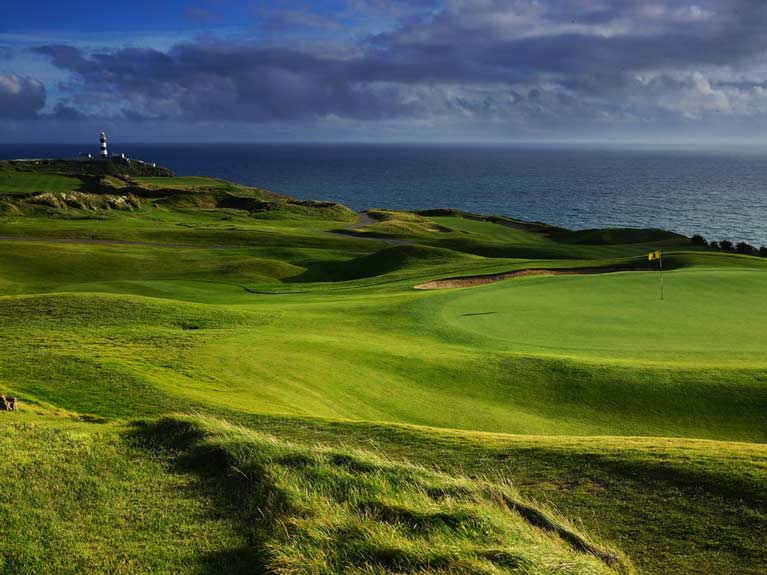 The Old Head Golf Course near Kinsale – it may be very artificially green, but it is preferable to industrial or urban sprawl
The Old Head Golf Course near Kinsale – it may be very artificially green, but it is preferable to industrial or urban sprawl
As for the people for whom golf is pleasantly sedating, they cause trouble to no-one. An experienced hotelier in the west of Ireland once told me that the golfer is the perfect guest, easily pleased if you’ve the proper hospitality skills, and no trouble to anyone. He or she will return to the inn in a relaxed frame of mind after one or two rounds of their beloved game, and for dinner they’ll invariably have a steak with a bottle of red wine. Then they’ll retire peacefully to their rooms maybe with another bottle or a pint of Guinness, and there they’ll settle down in bed and watch a golf video before sleeping serenely.
It’s an entire segment of society kept content with a sense of purpose. So when the disruptors talk of doing away with distantly-located “perfect” start lines and Race Officers who will not let the fleets away until a dozen wind requirements are fully met, do they (the disruptors) not have enough humanity in them to think about what might become of the not-inconsiderable corps of volunteers who currently man committee boats and back-up RIBs and mark boats and heaven only knows what else that floats and can usefully be deployed to ensure that a smaller number of people actually get in some sort of race?
For the fact of the matter is, a fully-crewed and effectively-equipped and properly-organised Committee Boat with its various support boats is arguably a floating Men’s Shed (and yes, I know there are many splendid women involved too, God bless them).
So if we go back to simple shore-based starts using transits as Nature intended rather than having fully-manned boats bobbing about at sea, what on earth is going to become of those who have been called to Committee Boat service? For it’s not for everyone – it’s a sort of secret society, and there’s an invisible vetting process.
Either way, if we just pack a race officer into a little pier-end hut with a time-keeper and a records secretary and set up the transits for a reasonable start and then let the sailors at it within a few yards of the harbour mouth, we’re inevitably going to cast all those Committee Boat folk, mark buoy boys, and umpires into a sort of purposeless outer darkness.
Perhaps they can take up golf…..Meanwhile, before this column is swamped into obliteration under an onslaught of Olympic Sailing Purity of Opinion, let it be pointed out that the Round Ireland Race starts from a shoreline, though admittedly with the race officer at the outer end in a Naval Service vessel if there’s one available. Elsewhere, much of Cowes Week and all of the Fastnet Race starts from a fixed shoreline. And as for the course, that’s then sailed, very little of it is round artificial marks other than established navigation buoys.
 Crazy but it works – the start of the Round Ireland Race 2014 as seen from the Wicklow pierhead
Crazy but it works – the start of the Round Ireland Race 2014 as seen from the Wicklow pierhead
And for those who object to racing where the effect of land regularly intrudes, just remember that the most popular participant sailing events in the world are the Round the Island Race around the Isle of Wight in the south of England, and the Round Gotland Race and other huge events involving close inshore stuff on islands in the Baltic.
Clearly, it’s what people want. And as for fancy Olympic courses in slightly remote area (ie more than two miles away from the harbour), they’re now soooo yesterday……Club sailors want convenience. If they want to go for a sail, they’ll simply go for a sail. But if they want a race, they don’t want to have to go for a sail before it. They want racing, and they want it now.
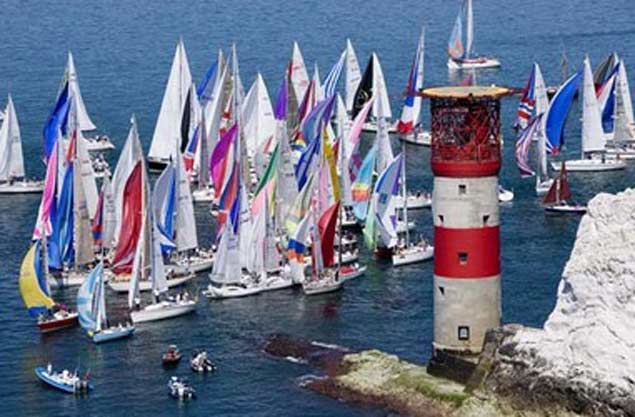 It’s sailing sport of a kind, but definitely not Olympic – the fleet in the Round the Island Race at the Needles, were those really cutting the corner have to be sure they pass safely inside the remains of a hidden shipwreck……
It’s sailing sport of a kind, but definitely not Olympic – the fleet in the Round the Island Race at the Needles, were those really cutting the corner have to be sure they pass safely inside the remains of a hidden shipwreck……
For a while, the ancient Howth 17s were told that the only racing that could be provided for them on a Saturday afternoon would be with the Puppeteer 22s (which carry an outboard auxiliary engine) at a Committee Boat start north of Ireland’s Eye in a supposedly clear area.
Yet if a calm fell, the Seventeens had to resort to a long oar, which was and is brutal to row with, and that’s it. So they rebelled, organized their own Race Officer rota for starts at the old pierhead line which they could reach within minutes from their moorings, and they’ve never looked back since. Saturday afternoon racing is the highlight of the week. So maybe if sailing organisers went by the old dictum of the customer being king, we might see club sailing becoming more healthy.
Here’s a vid of the Round the Island Race which usually starts at an ungodly hour of the morning, yet if you have a handy berth in the outer reaches of Cowes Harbour, you can leave it with just a quarter of an hour to go to your start. We’re not recommending that, but it can be done……
And as for those who like to claim that their nearest “clear area” really does minimize the need for local knowledge almost completely, let us remember the time when John Bertrand, America’s Cup-winning helm for Australia in 1983, finally achieved his true goal in life – becoming Etchells 22 World Champion in 2010, when it was staged in Howth.
For sure, the race area was set in the “clean zone” well clear of Howth, northwards between Ireland’s Eye and Lambay. But despite that, John Bertrand – whose crew for the big event was to include Tom Slingsby – spent six weeks (repeat: 6 weeks) in Howth beforehand, sailing his Etchells 22 morning, noon and night in the race area in order to get a complete feel for it and its many moods. He certainly deserved to win. But a bit of old-fashioned racing using a clear transit-marked shore-based starting line might have been more fun.
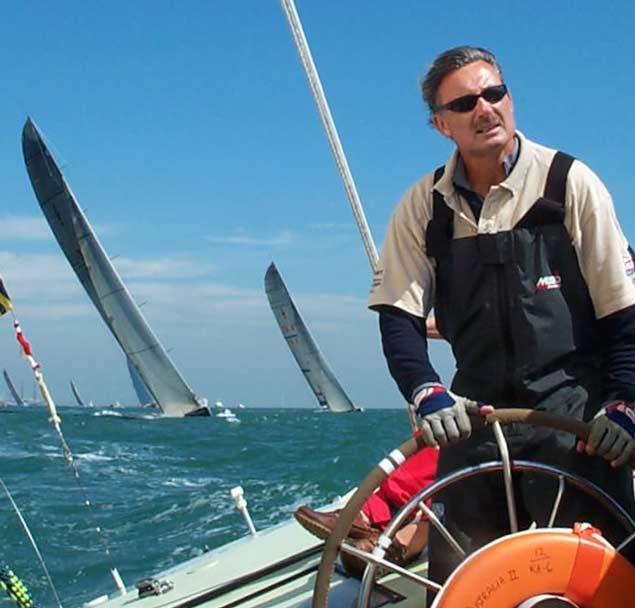 John Bertrand of Australia, who wrested the America’s Cup from the USA in 1983 for the first time since they originally won it in 1851. In 2010, he spent several weeks familiarizing himself with the “clear zone” sailing area off Howth before he raced on it to win the Etchells 22 Worlds
John Bertrand of Australia, who wrested the America’s Cup from the USA in 1983 for the first time since they originally won it in 1851. In 2010, he spent several weeks familiarizing himself with the “clear zone” sailing area off Howth before he raced on it to win the Etchells 22 Worlds
St. Michael’s Rowing Club will host The Hobblers Challenge on the 7th of September. The challenge is a 28km endurance coastal rowing race, which has been taking place since the 1990s on Dublin Bay.
Several courses have been used, predominantly from Dún Laoghaire Harbour to the Kish Lighthouse and back.
Four categories will compete this year: Ladies, Men, Mixed and Under 21.
The current course, set in 2017, starts at Dun Laoghaire Harbour, at the East Breakwater beneath the Hobblers Memorial, out the harbour mouth, around the landward side of a ‘gate boat’ off Merrion Strand, around Poolbeg Lighthouse, up the Liffey as far as the ESB towers, before doubling back, across the mouth of Dun Laoghaire Harbour, across Scotsman’s Bay, past Sandycove and Bullock Harbours, turning at Coliemore Harbour, before returning to Dun Laoghaire Harbour, finishing at the end of the East Breakwater.
“We are delighted to host this endurance race again. Similar to previous years, the competition is open for traditional skiffs so we are hoping to get as many East Coast rowing clubs taking part as possible,” said James Tedd, St. Michael’s Club Chairperson and race organiser.
Participants can choose between four categories: Ladies, Men, Mixed and Under21. “The latter two are an addition to the 2018 race,” explained Eoin Clarke, Race Registration Officer. “ We aim to be inclusive to experienced rowers of all ages, and we hope that, by introducing the Under21 category, we can help young rowers who transition from the youth level to the adult one get a taste for what endurance racing is, by competing against rowers of the same age. ”
The best times to complete the challenge are 2h47min - a record held by the St. Michaels’ men 2018, and 3h 3min - a record held by the St. Michaels’ ladies. Both records were set in 2018.
Detention of Fishing Vessel off Dublin Coast for Alleged Breach of Fishing Regulations
The Irish Defence Forces, reports Journal.ie, have detained a fishing vessel off the coast of Dublin (yesterday) for allegedly breaching fishing regulations.
The vessel was stopped 20 nautical miles northeast of Howth in Co Dublin by the Naval Service Vessel LÉ George Bernard Shaw.
The boat was brought back to Howth where it was handed over to An Garda Síochána.
This is the seventh vessel detained by the Naval Service so far in 2019, according to Defence Forces spokesperson.
“The Defence Forces conducts at sea fishery inspections in line with the service level agreement with the Sea Fishery Protection Authority, as part of its delivery of government services to the state,” they added.
DBSC Results for 17th August 2019
Race 1
Cruiser 0 IRC: 1. Wow, 2. D-Tox
Cruiser 0 Echo: 1. Wow, 2. D-Tox
Cruiser 1 IRC: 1. White Mischief, 2. Gringo, 3. Bon Exemple
Cruiser 1 Echo: 1. White Mischief, 2. Gringo, 3. Bon Exemple
Cruiser 1 J109: 1. White Mischief
31.7 One Design: 1. Prospect, 2. Levante, 3. Attitude
31.7 Echo: 1. Fiddly Bits, 2. Attitude, 3. Levante
Cruiser 2 IRC: 1. Peridot, 2. Windjammer, 3. Rupert
Cruiser 2 Echo: 1. Springer, 2. Windjammer, 3. Peridot
Cruiser 2 Sigma 33: 1. Rupert, 2. Springer, 3. Pastiche
Cruiser 5 NS-IRC: 1. Persistence
Cruiser 5 Echo: 1. Spirit, 2. Persistence
SB20: 1. Carpe Diem, 2. Venuesworld.com, 3. Sea Biscuit
Flying 15: 1. No Name, 2. Ignis Caput II, 3. Glass Half Full
Ruffian: 1. Ripples, 2. Ruffles, 3. Alias
Shipman: 1. Barossa, 2. Viking, 3. Jo Slim
B211 One Design: 1. Yikes
B211 Echo: 1. Yikes
Mermaid: 1. Red Seal
Race 2
SB20: 1. Venuesworld.com, 2. Carpe Diem, 3. Sea Biscuit
Flying 15: 1. No Name, 2. Ignis Caput II, 3. Betty
Whitbread Race competitor Angela Heath will join regular Dublin Bay helms Jean Mitton and Alison Clarke among the inspiring and influential Irish women taking part in the first Pathfinder Women at the Helm event next month.
This new event “encourages women to embrace a role of leadership on the water, and set an example for future female sailors so that helming becomes the norm”. Registration is open HERE.
Despite boys and girls competing against each other in single-handed dinghies, it’s still uncommon to see women leading their own crew, says Irish Sailing. Yet there are many strong women quietly pursuing their passion for sailing.
Among them is Jean Mitton of the Royal St George, who when she started out was often the only woman on a crew outside of family outings.
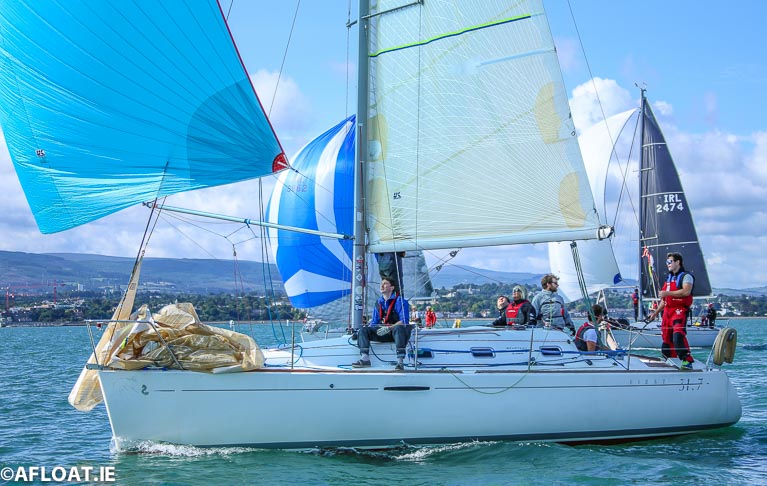 Jean Mitton (second from left) on board the family 31.7 Photo: Afloat
Jean Mitton (second from left) on board the family 31.7 Photo: Afloat
“Facing challenges while on the boat has given me the full sailing experience and made me confident in my ability to be at the helm,” says the now 12-year veteran.
 Alison Clarke (left) onboard the Quarter Tonner CrI Cri Photo: Afloat
Alison Clarke (left) onboard the Quarter Tonner CrI Cri Photo: Afloat
It’s a feeling shared by Alison Clarke, who will be helming the boat she regularly crews — Paul Colton’s Cri Cri — in the event over the weekend of Saturday 17 and Sunday 18 August at the National Yacht Club.
“Sailing has taught me things about leadership that you can’t learn in a classroom or from a textbook,” she says.
Both Jean and Alison surely took inspiration from the likes of Angela Heath, who was part of the pioneering all-woman crew of Tracy Edwards’ Maiden. And now they will have the opportunity to test their skills against Angela as she helms the Beneteau 31.7 Crazy Horse.
 The Beneteau 31.7 Crazy Horse with Angela Heath in white top, second from right Photo: Afloat
The Beneteau 31.7 Crazy Horse with Angela Heath in white top, second from right Photo: Afloat
Angela will also be taking part in a Q&A following a screening on Friday 16 August (National Yacht Club, 6.30pm) of the documentary Maiden, which charts the highs and lows of Edwards and crew in the 1989 edition of the world’s most challenging round-the-world sailing race.
The Muglins light off Dalkey which marks the southern approaches of Dublin Bay has recently been inspected and recieved routine maintenance, writes Jehan Ashmore.
According to the Commissioners of Irish Lights, the light is an effective and conspicuous aids to navigation (AtoN) for the approaches to Dublin Bay from the south, both during the day and at night.
ILV Granauile, the Irish Lights aids to navigation tender which visits The Muglins (p.13) on an annual basis this year took an anchorage closer to Lamb Island. This is the largest of several smaller islands that form a protective chain leading off Dalkey Island which is closer to the mainland (300 metres) compared to The Muglins which is more exposed been some 500m north-east and situated further out in Dublin Bay.
As part of the Irish Lights' annual planned maintenance programme, work on The Muglins began last Tuesday. This involved a range of checks on the light, the solar panel system (see photo: at top of light) as well as the structure of the tower and the boat landing where Afloat observed a tender from ILV Granuaile transfer personnel and equipment onto the rockey islet.
In addition at The Muglins a risk assessment took place and checks were completed for the station which sports a distinctive white and red band scheme. Noting the inclusion of the central red band was adopted in 1883, three years after the light then designated a beacon (a 30ft stone built structure and conical in shape) was erected according to Bill Long author of 'Bright Light, White Water'. It was between the 9th to 18th centuries where Dublin was far from ideal to conduct itself as a port from which to conduct foreign trade.
Access to Dublin was dangerous due to constantly shifting sandbanks and so Dalkey, two miles south-east of Dun Loaghaire, saw during the Middle Ages for the most part ships instead of using the Port of Dublin took an alternative in Dalkey Sound which afforded relative shelter when at anchorage. This enabled transferring cargoes by lighters ashore to Dalkey's seven fortified town houses/castles built to store the goods which were off-loaded in Dalkey in the Middle Ages, when Dalkey acted as the port for Dublin.
The Muglins forms part of the Dublin Bay aids to navigation group and it is at the islet where for a long time posed a dangerous hazard to mariners and caused many ships to flounder in these waters. This led to the harbourmaster of Kingstown (Dun Laoghaire), Captain William Hutchison in 1873 to plea for a light to be sited on 'these siren rocks'.
Despite a subesquent list of vessels numbering 12 that Captain Hutchison furnished to the respective authorities at that time, there was indecision between Trinity House, The Board of Trade and the Commissioners of Irish Lights on the plea to erect a light for seafarers. All was too change when a 13th wreck was added by the Captain which ultimately raised the issue again and saw plans to commission the light which was eventually completed in 1880.
In addition to the recent works at The Muglins, ILV Granuaile then proceeded to neighbouring Killiney Bay. Following an overnight anchorage operations took place in a central area closer to the open sea where the coastal shipping lane for Dublin Port is busy with traffic.
The work in Killiney Bay involved ILV Granuaile at an outfall buoy which was contract work that Irish Lights carry out on behalf of Irish Water and where the Shangannagh /Bray Wastewater Treatment Plant (page 3) is located on the shore of the bay near Shankill. The plant close to the Co. Wicklow border was upgraded in 2011 and is capable of treating 43,700m³ of wastewater a day and according to Water Technology is estimated to serve a population of 248,000 people.
The infrastructure upgrade at the plant was carried out by Dun Laoghaire-Rathdown County Council in association with Wicklow County Council and Bray Town Council. The aim of the upgrade on the existing facility was to ensure the plant be in accordance with the Urban Wastewater Treatment Directive and associated Irish Regulations. In addition it allowed the new facility to comply with other EU directives and national regulations meant for environment protection.




























